|
FAQs about the Diseases
of Clownfishes
27
Related FAQs: Clownfish Disease 1, Diseases of Clownfishes 2, Diseases of Clownfishes 3, Clownfish Disease 4, Clownfish Disease 5, Clownfish Disease 6, Clownfish Disease 7, Clownfish Disease 8, Clownfish Disease 9, Clownfish Disease 10, Clownfish Disease 11, Clownfish Disease 12, Clownfish Disease 13, Clownfish Disease 14, Clownfish Disease 15, Clownfish Disease 16, Clownfish Disease 17, Clownfish Disease 18, Clownfish Disease 19, Clownfish Disease 20, Clownfish Disease 21, Clownfish Disease 22,
Clownfish
Disease 23, Clownfish Disease 24,
Clownfish Disease 25,
Clownfish Disease 26,
& FAQs on
Clownfish Disease By: Environmental
Stress, Nutrition, Social/Behavioral/Territoriality, Trauma/Mechanical Injury, & Pathogens:
Lymphocystis, Infectious Disease (Bacteria, Fungi...),
Protozoans: Cryptocaryon/Ich,
Amyloodinium/Velvet, Brooklynella (see article below), &
Mysteries/Anomalous Losses, Cure, Success Stories, & Clownfishes in General, Clownfish Identification, Clownfish Selection, Clownfish Compatibility, Clownfish Behavior, Clownfish Systems, Clownfish Feeding, Clownfishes and Anemones,
Breeding
Clowns,
Related Articles: Clownfish Disease, Clownfishes, Maroon
Clowns, Marine Disease, Brooklynellosis,
|
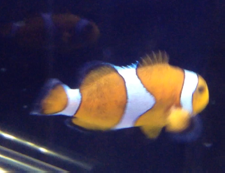
|
|
Ulcer? 4/27/20
Good evening.
<Hey Hector>
I asked my friend about an ulcerative lesion on my clown’s jaw, and he told
me to email you.
Here it goes.
Just noticed it today. It’s not eating because the mouth is constantly open.
I plan on quarantining, but don’t know what meds I should try.
<Mmm; unfortunately there is no treatment for such a situation (that I'm
aware of); on the plus side, having seen and read re similar circumstances I
don't consider that this condition is "catching"... that is, it won't spread
to other livestock>
Thank you for your time.
Best regards,
Hector
<Were it my fish, I'd keep it as long as it doesn't seem to be suffering.
Otherwise, please see Neale's piece here on euthanasia:
http://www.wetwebmedia.com/euthanasia.htm
Bob Fenner>
|
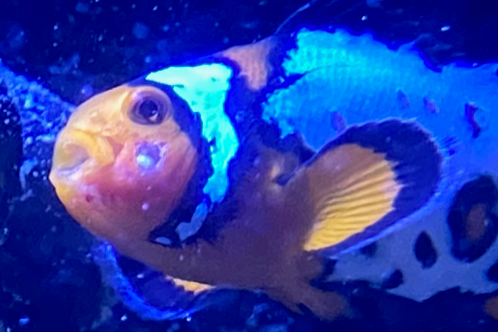 |
|
Re: Ulcer? 4/27/20
Thanks for your prompt response.
Hector
<Certainly welcome. BobF>
|
|
Ocellaris with black / dark patches 11/21/19
<Hi Eduardo, could you please crop, resize down your pix to just a few megs
and resend them?... otherwise you will crash our server. Cheers. Wil.>
Re: Ocellaris with black / dark patches 11/21/19
Hello Will, thanks for your response.
<Most welcome>
I'll answer your questions directly on the body of the email. Cheers. Ed.
Well, I've been in the hobby for quite some time and even though I've seen a
lot I came across something I'm uncertain about.
<Let’s see>
The male of ocellaris pair is showing some dark brown / black patches in the
lower part of his body going from the middle back to its tail, and uncertain
to what it is.
<Do these patches appeared suddenly?>
<<Yes they seem to have appeared suddenly>>
<Ok>
My pair have hosted some sort of olive/brown Palythoas for over 2 years.
I've seen the female and male with stung marks before but they are always
dark dots and not blotches.
<Maybe it was stung by another coral>
<<It could've been the new frog>>
<Yes>
I haven't checked my param.s, this week, but I keep them at ~400Ca, 1300+Mg,
7.7+Kh, will check my phosphates as I did have a power outage today that
lasted 5hrs (kept an air pump running the whole time), Nitrates <10ppm.
I will check them tomorrow again to see if anything is off, even with the
power outage I doubt it as all the corals and inverts are doing fine.
<How about the other readings...ammonia, nitrites, ph, specific gravity,
temperature?>
<<Haven't check ammonia, nitrite or ph for a while. SG is 1.025. I did have
a power outage that lasted for 5 hrs and I placed an air pump through the
whole time, temperature dropped to 24.6 but I keep it from 24.5 to 25.7 also
used a Biodigest vial and stop ammo vial after the power outage>>
<Mmm... am not a fan of additives, more of the idea of doing partial water
changes to dilute accumulated wastes, after power outages.>
I do keep softies like Zoas, Palys and mush, LPS Trumpets, Frog and hammers,
and SPS a few Acros , Montis chalices and such.
<These can irritate the clown’s skin specially in small / crowded quarters;
what is the size of your system?>
<<Is well over a 75g + 30 gal sump plus the frog is almost a foot to the
left and half a foot to the top away from where they stay in their Palys (It
does have 1 green Paly that recently got mixed with the olive ones)>>
Aside from the ocellaris, I also have a Cleaner Wrasse and a Mandarin fish
on that system, as well as a Cleaner shrimp, few hermits and snails.
The mandarin, wrasse and cleaner shrimp were added a few months ago and they
are all eating and acting normal. My last addition was a frog that i got
from a friend yesterday, he's reef is over 6 years old with a pair of
ocellaris that have almost 10 years (from a previous reef) and I only dipped
it in Revive and Lugol. It's doing fine right now. All my fish seem to be
acting normal, I did notice the wrasse a bit awkward, however eating
regularly, but I will need to confirm it. The female is showing a some dark
patches but much less than the male.
<I suspect the recently added Euphyllia may have to do with this>
<<Could be, but if it is far away should I worry about it going closer to
the frog?>>
<We can’t be 100% sure it will not.>
I'm attaching a few pics of my ocellaris, I'd appreciate if you could share
some info, or if you have come across something like this before. I will
pull the ocellaris out the tank it gets worse, but right now I'm only
observing as he is eating and swimming well, although he does seem to be
swimming in the current and opening up his mouth widely from time to time, I
know this symptoms resemble velvet, and I do have a Hospital Tank with
copper for about a month (covered with plastic to prevent aerosol
transmission) next to it and a QT tank on one side but I doubt it is velvet
or it would have already taken on the fish very fast and the patches doesn't
resemble velvet. One Idea that has come to my mind is predatory dinos after
the power outage. Thanks before hand, any help will be appreciate it.
<This appears to be "Hyper- Melanization" which is caused by stinging
organisms like the ones you have, I’d see if the blotches disseminate to the
rest of the clown’s body or if they fade away over the course of a few days,
if not, you’ll need to remove the offending life form, this can be difficult
to identify as it may be stinging the clownfish at night if/when the fish
swims nearby and touches it... again, I suspect of the Frogspawn.>
<<Very well, I'll keep an eye for any changes, the patches seemed to be not
spreading so that is good, and the clownfish is acting normal. Thanks again
for your help Will>>
<Please keep us posted. Wil.>
|
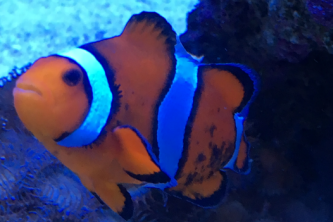 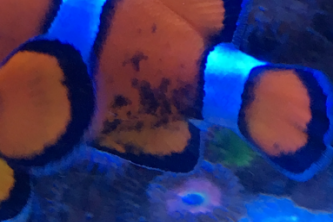 |
|
Top Fin Damage 11/15/19
Hello,
<Hey Nick>
Here are a couple pictures of my Amphiprion Ocellaris Clown. Three weeks ago I
noticed the top fin was looking white and he would rarely extend it. I've been
monitoring it and it didn't look like it was getting any worse till yesterday.
The white area looks like it's at the top of the body now.
He lived in a 55 gal tank for 5 years, and earlier this year I moved everything
into a 75 gal. The tank is stable. I haven't lost any fish in five years. I've
introduced a few corals (dipped) and some snails over the last few months. Fish:
2 clowns, 1 Royal Gramma, 2 Blue Chromis which are smaller than the clowns. The
Clowns sleep in a frogspawn. Sometimes the Royal Gramma will nip at the clowns,
but not enough to even make them swim away. Two small hermit crabs. He acts
healthy and normal, eats well.
Does this look like physical damage that needs time to heal? Is it more likely a
disease of some kind? What remedy should I employ?
I appreciate your advice!
<Does look like physical damage, this kind of wound is typically caused
by a nipping tank mate, watch carefully to identify the bully and isolate it.
This wound should heal in a few weeks.>
Thanks, Nick
<Welcome. Wil.>
|
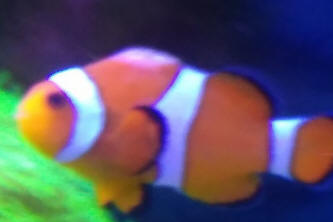 .jpg) |
|
Re: Top Fin Damage 11/23/19
Here is an updated picture of the top fin. It looks like even the top of the
body is affected at this point. The whitish coloration lower on his body is a
smear on the glass. The rest of the body looks fine, other than the top fin.
Does this still appear to be physical damage and not some other ailment? I
haven't found the culprit yet.
<Does look like an open wound... If environmental conditions are not ideal, it
will take longer to heal, I’d do small partial water changes (10 to 15%) two or
three times a week, add vitamin supplements to the fish diet and start using
activated carbon.>
Should I remove the wounded fish, and place in a hospital tank till recovery? It
seems that would be additional stress, but maybe worth it?
<Worth trying, this way you’ll also know if another fish was nipping at it.>
Much appreciate!
<Cheers. Wil.>
|
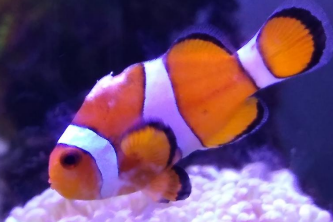 |
|
Clownfish Hyperventilating 9/22/19
Good Morning, this morning I woke up to my clownfish on the bottom of the tank
hyperventilating as soon as it saw me he tried swimming up. It’s been an hour
and he is still fighting whatever it is off he maintains itself upright. I
checked my perimeters <parameters likely> and they’re fine I’m lowering my
salinity little by little I’m not sure it yesterday I saw stringy poop or not so
I’m not sure if he’s sick with parasites or just sick. I have had the tank for 4
months and the clownfish for 3 months he was doing just fine until today. I need
help please!
<When, where in doubt, water changes! I'd switch out a quarter or so of the tank
water, via gravel vacuuming... Stat! Unless you have another established,
suitable system to move the fish to. Bob Fenner>
|
Faded clownfish... beginner, chatting
6/29/19
Hi my name is Brian delp
<Hi Bryan>
I have a clownfish that I just purchased a week ago and yesterday his orange
color has faded a lot and his he's swimming
around real fast up by power head and then he will swim in between heater
and the glass..he's been doing fine all this time and just like that total
change his swimming is very erratic and it doesn't seem like he's eating but
he was eating the day before he is being housed in a Nano 24 tank
<At first glance, I would say, it is stressed by environmental conditions
but, I need to know more about your tank; water parameters, filtration, tank
mates, maintenance practices...
Thanks
Brian Delp
< You´re welcome. Wil.>
|
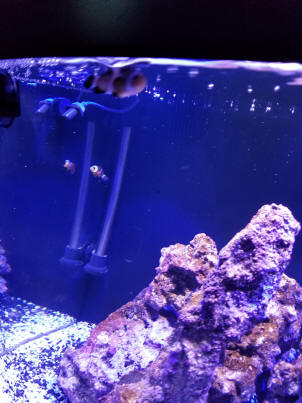
Yeah; some consideration now. |
|
Re: Faded clownfish
6/29/19
2 clowns total and 1 red star fish so far
Ph is 8.2 ammonia 0 and salinity is 1.026 and the test after ammonia is 0
and the 4th test was in the middle < ?? > I'm not at home now my other clown
is
fine which is the smaller of the 2 they were both fine yesterday morning
<How about nitrites and nitrates?...Wil.>
Re: Faded clownfish
6/29/19
The test after ammonia test is 0 and test after that was in the middle for
the master testing don't remember the 1 number
<Brian, please send us more accurate information of your water parameters,
nitrites, nitrates, water temperature, and if possible an image of your
clown fish; it is hard to diagnose with just ammonia info. Cheers. Wil.>
Re: Faded clownfish
6/29/19
Ammonia. 25, nitrite 1.0 and nitrate 20ppm,
<Too high, toxic levels, only nitrates are in a safe range>
Water temp 76 degrees just tested again to double check and I just did a
10% water change tank has only been running since may 7th it's a new tank
<I can see in your pic that your clown fish is stressed, I would do more
partial water changes, also your water surface looks stagnant, do you have
enough water movement/ oxygenation? What is your biological filter composed
of, only live rock, how many pounds? Do you run a protein skimmer? Your tank
is relatively new and may not be completely established. Wil.>
|
Question about sudden clownfish behavior change
6/6/19
Hello!
<Hello Camille, Wil, here today>
I've been looking on the web and I can't seem to find an answer for my
clownfish's sudden behavior change. I have a 30-gallon, 3-year-old established
saltwater tank, recently my Firefish died, now the only inhabitants of my tank
are my clownfish and a snail.
<Did the Firefish die with no signs of illness?>
While my Firefish and clownfish were together, the Firefish was quite shy and my
clownfish was quite obviously the dominant one.
<Yes Clownfishes are very dominant / territorial>
He would always swim throughout the tank and was very quick to leave the rocks
at feeding time and dash around to catch food. About a month ago my Firefish
passed, and since then my clownfish has been hiding in the rocks and has been
very timid during feeding, almost as if he is scared to come out.
< Have you check your water parameters lately?>
I believe is much too late to introduce a new fish to the tank, especially with
a clownfish, but I'm worried about him.
<You may introduce new fish but rearranging your rockwork so that the clownfish
“forgets” its territory, also, if you introduce more than one fish at the same
time, it will be less likely that the clown nip at them, since aggression is
divided in more than one target.>
Do you have any answers for what I could do to help him return to his old
personality, or any answers if the death of my Firefish has anything to do with
the behavior change?
<Hard to tell without more info about your tank, please send us more detailed
information.>
Thank you so much!
<Glad to help. Wil.>
Re: Question about sudden clownfish behavior change
6/6/19
Thank you so much to answer your questions:
1. My Firefish did die suddenly, she is always very shy and I hadn’t really seen
her, and when I went to feed the fish she was dead at the bottom on the tank. I
checked the levels as soon as I removed her and they were perfect.
< “Perfect” doesn't say much, there are many other factors that may have been
the cause of death, sometimes fish just don’t acclimate to an aquarium even
under the best conditions.>
2. He is definitely quite territorial he has his 2 rocks that he’s always by -
but more than usual lately.
<Probably stressed by something not seen at plain sight, maybe environmental.>
3. I just checked my water levels and they are all perfect.
<Please send us the exact readings>
4. I’m not sure if I really want to introduce new fish because I have had the
tank for a while now, and once my clownfish passes I probably won’t purchase
more fish for a while.
<I understand>
But would rearranging the rocks help my clownfish become more lively again?
<Perhaps...worth trying, I would make a partial water change too.>
5. Like I said the tank is 3 yrs old and very established, I have had my
clownfish since the tank was ready (bacteria wise), it’s a taller 30 gallon, not
a wider one. It has 4 dead rocks, no live corals or plants. A good heater, a
solid circulation pump. And a new and more powerful filter I purchased shortly
after my Firefish died.
<What type of filter?... do you have a protein skimmer?
Thank you for all your help!
Camille
<You’re most welcome. Wil.>
Re: Question about sudden clownfish behavior change
6/6/19
Hi Wil,
<Hi Camille>
My levels are:
Ph: 7.8
<Yikes!... that´s way too low! try to rise it slowly to 8.3 with a buffer
product.>
Ammonia: 0ppm
Nitrite: 0ppm
Nitrate:0ppm
<Have you check your test kit expiration date?... reagents go bad with time>
Salinity: 1.026
<1024-1025 would be just fine... is your Hydrometer working well?
I think I will do a partial water change and rearrange the tank.
<Please do>
My filter is a penguin bio-wheel 150, and I don’t have a protein skimmer.
<I recommend you to get a good skimmer>
Thank you!
Camille
<You´re welcome Camille. Wil.>
Re: Question about sudden clownfish behavior change
6/6/19
Sorry the specific gravity is 1.026, the salinity is about 34ppt.
<Ok Camille. Wil.>
|
Need help with sick Ocellaris clown
6/23/17
Hi there,
<Bette>
I am new to your site as an e-mail questioner. I have read and utilized much of
your "on site" advice in the past. Unfortunately this time I can't seem to find
answers to my specific situation.
<Okay>
I have a 70 gallon plus refuge and sump FOWLR system. I run a protein skimmer.
It is 6 years old. Salinity 1.023 per refractometer, Temp kept at 79.3 - 79.5
F., pH - 8.0, Ammonia - 0ppm, Nitrite - 0ppm, Nitrate at or below 5.0PPM. Oxygen
by Salifert test usually around 8 mg/L but is low today probably as a result of
using PraziPro. At 5-6 mg/L. I have removed the cup from the skimmer and am
letting it run to try to add oxygen.
Tank community is 2 Chromis, 1 Damsel, 1 Dwarf Flame Angel, I wrasse, 1purple
Firefish, 1 goby, a peppermint shrimp, two emerald crabs, several snails and a
pair of black ocellaris clowns. No one is new and there is no bullying or
territorialism going on. The female clown is large at 3 inches.
My issue is with my female clown. I have had her for 5 years with no problems.
Three days ago she started acting lethargic and stopped eating.
I noticed both she and the dwarf angel had white stringy poo so I
started a treatment of PraziPro thinking I may have gotten some kind of parasite
in the tank.
<A "worm" type... you thought/think>
I find no other observable symptoms. She goes from hanging in her "tube" with
her mate (see picture) to sitting in the bottom corner of the tank by her
favorite fake anemone - sometimes she seems to be lying on her side up against
the glass. When she does swim she is mostly vertical in the corner of the tank.
These are not normal behaviors for her. She is still turning down all food -
pellet, flake, frozen Mysis shrimp.
1. Am I right with thinking parasite?
<Mmm; not necessarily, no>
2. Any other possibilities?
<All sorts; from there being nothing going on here. Amphiprionines are
termed "Clowns" for more than their garish appearances. Their natural behavior
includes all you've listed here>
3. How long can she go without eating before it is a real problem?
<A few weeks likely>
4. I have an isolation tank but hesitate to move her since it will cause added
stress and I will have to also move her mate as he gets very stressed whenever
she is away.
<I wouldn't move this fish... would "punt", and do a bit of a major clean up
here... vacuum the substrate, change about a quarter of the water; move the
decor>
5. If it is a parasite and PraziPro is working - how long before I should see
some kind of improvement?
<Mmm; parasites includes a wide array of phyla; including "vermes" of many
sorts, but also Protozoans, crustaceans, and more that PraziPro does not treat.
IF you have a microscope, want to sample some of the feces, we could
go over what, if anything may be found. Otherwise, for shotgun treatments, some
institutions, individuals try the vermifuge with the anti-protozoal (and
moderately antimicrobial) Metronidazole. T'were these fish mine, I'd try some
other foods of high palatability (e.g. Spectrum or Hikari pelleted),
frozen/defrosted... perhaps a liquid vitamin, HUFA prep. added to the food and
water... and be patient>
6. What symptoms would indicate she is worse?
<Increasing malaise, thinness>
THANK YOU!!!
<Welcome. Bob Fenner>
Re: Need help with sick Ocellaris clown 6/23/17
Bob -
<Ms. M>
As you said this is usually "normal" behavior for clowns but in this situation
since I have had her a number of years - she is not acting normally. I will
however take your advice and try to be patient.
<A virtue indeed.>
So many times it is too late to really have any effect once I start seeing
symptoms. I have already done a substrate vacuum and water change. I hesitate to
move a lot of the décor as it would upset many of the other residents ��. Good
idea on the different food - I will do that right away. I have never used
Metronidazole. Are you suggesting using it with the PraziPro?
<I would not continue to use either of these... more than a recommended regimen.
Both are hard on fishes, the system. Better by far that they're administered via
foods... Bob Fenner>
|
.jpg) |
|
Re: Need help with sick Ocellaris clown
6/24/17
Good morning Bob,
<Hey Bette>
Just wanted to give you a follow-up. I'm betting there are quite a few times you
give advice and never hear the outcome. I followed your advice to not give any
further medication and just be PATIENT. This morning my clown is eating a bit
and acting like herself - more clown-like. Looks like we weathered this bug-
whatever it was.
Thanks again
Bette
<Ahh, tres bien. Thank you for the follow-up. BobF>
|
What happened? Myst. Clown Loss 5/9/17
Hi WWM Crew,
<Eddie>
I told myself last time that I wasn’t going to email with any more questions for
a while, but I truly am puzzled by what happened this weekend, so here I am
again. It was time to add the first fish to my system. I set the system up at
the end of February, and I put in the live rock the first week of March. Then
Saturday I went and got my first fish—a clownfish (Amphiprion ocellaris). I also
got a cleaner shrimp (Lysmata amboinensis). I brought them home and acclimated
them as usual: I float the bags in the tank they are going into for 15 to 30
minutes, then I slowly add a little tank water to the bag, and pour out a little
water from the bag into a bucket until the ph, temp, and Spg are the same, then
I release the animal into the tank. This took a couple of hours. In this case I
put the clown and the shrimp directly into the DT. I didn’t quarantine the clown
because he was to be the first fish in the tank. I figured if he had a problem I
could catch him for treatment. I didn’t expect to have problems because he was a
tank bred clown, and I have kept them before without issue.
He seemed OK during the acclimation and when I first put him in the tank he swam
behind some of the live rock where he remained for the rest of the evening. I
had the light out, so I couldn’t see him well but he was swimming in the current
back there—kind of swimming in place with that “waggle” that clownfish do. The
next morning when I got up and checked on him, he was sitting in the sand
upright, but not swimming. He had found a place against the glass where the
current wasn’t as strong and was just sitting there. This concerned me, but not
terribly because I thought he might have selected this spot to sleep in—I’ve had
tank bred clowns before that have slept in weird places. I had one that would
sleep at the surface of the tank, up in a corner, just floating there on his
side—he did that for several years. But when I looked more closely at this fish
I noticed that he was breathing really hard. I’ve never seen a fish pump his
gills that fast. I couldn’t do anything with him at this point because I had to
leave. When I got back several hours later he was dead. He died sometime between
13 and 16 hours after I put him in the tank.
<Mmm>
My first guess was that something was wrong with the water, but the shrimp was
fine (and still as), as was everything else in the tank: two turbo snails, three
blue leg hermit crabs, lots and lots of little snails and starfish from the live
rock, and a Kenya tree coral that hitchhiked in on the liverock. All my water
tests came up normal (see below). Do you have any ideas what could have killed
this fish?
<Only guesses. Might well be this one fish had some sort of trauma, predisposing
genetic issue...>
Is there a problem you can have with your water that would kill a fish that
fast, but not inverts?
<There are several possibilities here; yes>
Could it have been “clownfish disease” with a tank raised clown?
<Doubtful... perhaps it ate an organism that didn't "agree with it". Happens>
Could it have been the acclimation?
<Did you measure ammonia in the shipping water? See WWM re Guerilla Acclimation
(techniques); rarely issues w/ locally purchased, transported livestock though>
I live an hour and a half away from the LFS, so he was in the bag for three or
four hours total counting travel time and acclimation. I put the bag in an
insulated container for the trip home. This was never a problem before when I
got fish for my old system several years ago. I thought of one other
possibility. I had made a new Durso standpipe for the tank. The bulkhead is a
slip bulkhead and the one I had kept slipping out every now and then due to the
current from the circulation pumps. Anyway, I had made it with pvc cement the
day before.
<Actually; there is no such thing as PVC "cement"; the process involves a
solvent... Nothing left between the pipe, fittings... and a day is long enough
to cure>
I gave it more than 32 hours to dry and rinsed it thoroughly with water. While
the fish were acclimating, I installed it in the tank. Could there have been
something left over from the PVC cement that harmed this fish? It would have to
be something that didn’t harm the inverts.
<Agreed; and not this>
Anyway, while I am devastated to lose this fish, my biggest concern is for the
next fish that I get. If this was just one of those anomaly loses that sometimes
happens, that’s fine, but if it is something wrong with my water, I need to fix
it.
<I would "chalk the loss up" to the former and try another specimen m'self>
Water test and tank information:
· 75 gallon tank, 30 gallon sump (90 to 95 gallons of water)
· 42 lb. live rock and 35 lb. of previously live rock
· Spg: between 1.024 and 1.025
· Ph: 8.1
· dH: 10
· Am: 0
· Nitrite: 0
· Nitrate: 0 (live rock is handling this thus far)
· Calcium: 400
· Temperature 78
Thanks for your patient help with me as I re-venture into this world again. I
know I have bothered you all too often, but you have always patiently helped.
Thank you.
Eddie
<Never a bother. Thank you for writing Eddie. Bob Fenner>
Re: What happened? 5/9/17
Hi Bob,
<Hey Eddie>
Thanks for the lightening fast reply. I did check the ammonia in the shipping
bags, but I forgot at first. I had mixed in a little bit of system water before
I thought to do that. It was fairly early on though. It came out zero.
<Ahh; well; worth asking... Might be that a sudden shift in pH led to too much
stress through "ammonia burn">
I don't think this was it. It was only a couple of hours before I started mixing
the water in. Also I requested a bigger bag with more water in it because I had
so far to travel.
<Ah, good>
I always tried to do this when getting fish in the past. Anyway, I will try
again in a few weeks.
<Is what I would do too>
I was curious. You said that there are several possibilities for what could kill
a fish that fast but not inverts. I know disease might be one. What are the
others?
<Nitrogenous issues, low dissolved oxygen; thermal shock... There are several
more. Bob Fenner>
Re: What happened? Myst. Clownfish loss
5/12/17
Hi Bob,
<Hey Eddie>
I’ve been thinking about your reply for a couple of days ago, especially the
possibility of low dissolved oxygen.
<A very common issue with aquariums, particularly marine tropical>
I don’t think that is what killed this fish, because he was the only one in
there, but I do have a lot of confusion about dissolved oxygen and carbon
dioxide and how it relates to ph and possibly temperature. I am concerned that I
am not getting enough oxygen (or getting rid of enough carbon dioxide) to handle
the eventual fish load that I will have in the tank—or I may just be confused.
<Can have too little O2 and/or too much CO2... the higher temp., less solubility
and higher metabolism... In general, higher DO, higher pH, and the reverse for
CO2, carbonic acid in solution>
Back in 2012, when I had my old tank, I had a very enlightening conversation
with you about Ph that resulted in my reading all the Ph FAQs and learning a
lot. In that tank I had high Nitrates (that I was blissful unaware of) holding
the Ph down around 8.1. I came to understand that Ph is affected by the amount
dKH, the amount of calcium and magnesium, the amount of nitrates, and also the
amount of oxygen verses carbon dioxide. I know it’s way too simplistic, but how
I kept it straight in my mind is that if you had dKH between 8 and 12, Calcium
around 400 and magnesium in proportion, low Nitrates, and enough DO that your pH
ought to come out around 8.3 or so. I realize, of course, that I may still be
missing something.
<Mmm; you have a good grasp of the essential factors>
So now fast forward to my new tank. Ever since I set the tank up I’ve been
trying to figure out why my PH stays around 8.0. Over the last 2 ½ months it has
fluctuated from 7.9 to 8.1 (using two separate test kits—one brand new one). I
have a dKH of 10 to 11 all the time. My Calcium has been at 400 or slightly
higher. I don’t have any Nitrates yet (the live rock is taking care of them so
far). The only thing in the tank during this time has been the live rock (and
everything that came in with it), two snails and three blue leg hermit crabs
that I put in the first week of April, and the cleaner shrimp that I put in with
the fish on Saturday. So I concluded that I either wasn’t getting enough oxygen
or getting rid of enough Carbon dioxide to get the Ph any higher. I proved this
to myself the other night by taking a cup of tank water and aerating it for
about 3 hours with a small air pump/stone. The PH was 8.2 or 3 when I was
finished.
<Ahh!>
I was hoping to run my set up and some of the things I’ve tried by you to see if
I am missing something. So here goes . . .
It is a 75 gallon tank, 30 gallon sump (90 to 95 gallons total) with a >1” sand
bed 42lb of live rock and 35lb. of formerly live rock from the old tank. In the
sump I have an Aqua C EV 180 skimmer running on a Mag 7. My return pump is a Mag
7. I have plumbed two pvc returns over the back—each with locline at the end.
Initially I was getting around 325 to 335 total gph (after head loss). The
loclines are positioned so that the return water breaks the surface some as it
comes into the tank. In the tank I have twin circulation pumps run by a
Wavemaker. The flow rate is adjustable from 175 to 2000 gph each. I have
experimented with them several different ways. Right now I have them on opposite
ends of the tank about four inches from the top set two notches below full blast
with fairly short intervals. They are both pointed somewhat toward the surface
and I have a fair amount of turbulence.
<Good>
Much more and I would be nervous about it sloshing out. In fact this is why I
had to make the new standpipe. The turbulence kept shaking the old one loose. I
had them on full blast for a while, but a little lower in the tank and not
pointed upward (again because I didn’t want any water sloshing out).
I have two drains with Durso standpipes—an inch drain and a ¾ inch drain
(converted return on the 75 AGA). Both drop straight into the sump. The 30
gallon sump has three main sections. The first holds the skimmer (on a stand),
the skimmer pump, and the heater. This section has all kinds of surface
agitation/bubbles between the two drains and the skimmer return. Then, after a
set of baffles with a bubble trap is the refugium. I was originally going to
have a DSB in here, but I got too nervous because the sump was a used tank and I
didn’t want to push it. I have less than an inch of sand in it now and am going
to add a little crushed coral and live rock rubble and some small pieces of live
rock to raise pods. I’m also going to add some macro algae to it when I find a
store that carries it. I have a LED 15w Lights of America grow light suspended
over it. For the last week I have been doing a reverse daylight lighting program
with it. The last section of the sump holds the return pump.
Here are some things I have tried . . . I played around with the circulation
pumps, but it didn’t make much difference. Opening the skimmer drain all the way
seemed to help a little (I got a lot more turbulence in that part of the sump),
but it also slowed down the skimmer production some (not that I’m getting a lot
with a new tank without any fish anyway). I added an airstone with an air pump
to the sump. I’ve tried several air pumps actually, and have the most powerful
one that I have on it now. It was originally rated for 60 gallons, but it is old
and may not be getting quite that much. None of this seemed to help much. I
began to wonder if the problem is not aeration, but the inability of the carbon
dioxide to escape.
Since setting the tank up I had glass panels on the top of the DT in the front
half.
<This I was going to mention>
The back was open. I removed these the other day, but it didn’t help much (I
intend to probably leave these off and make some lids for the front and back out
of fiberglass window screen with eggcrate frames). This did help a little bit
with my heat problem. I had had a hard time with the tank getting up above 79
degrees in the afternoon (I had it set on 78). I was concerned about this with
summer coming on. Taking this glass off has helped with that. I have been able
gradually to bring the temp down to the 77 range. I know decreasing temperature
helps with capacity to hold oxygen. Does that mean that lower temperature would
increase PH?
<To some extent; yes>
I think though that if there is a problem with not enough Carbon Dioxide
out-gassing it is because of my stand cabinet arrangement. The stand is
homemade. It is a frame made out of 2x4’s and 2x6’s with 1/4” Oak panels on the
sides and doors on the front. The back (against the wall) is open. There is
about a 1 1/2” gap between the stand and the wall where air can enter the inside
of the cabinet. This is because I used a 2x4 as a mounting board between the
stand and wall to leave room for my over the back return plumbing. When the
cabinet doors are closed, this is the only way air can get in and out.
<Can you cut out some part of the door panels and insert some screening?>
Of course, most of my best aeration devices (the skimmer and the air pump) are
inside the cabinet. One other thing that I did is I put a sheet of glass (23” x
9.5”) along the back of the sump as a shield for splashing from the drains &
skimmer return. It is resting on the back lip of the sump, vertical on the long
side, leaning against the drain tubes. Point is it blocks a good bit of the
ventilation area at the back of the cabinet, but certainly not all of it. I’ve
tried leaving the cabinet doors open overnight, and it seems to help a
little—but I can’t leave them open all the time due to the noise of the pumps.
<May be time to trade these in...>
So I’m wondering if maybe the inside of the stand does not have enough access to
good oxygen to get it into the water. My next step is going to be to remove the
glass panel, but what after that? Should I put the air pump outside the cabinet?
<Worth trying>
Should I run some vinyl tubing from the skimmer’s air intake that goes out the
back of the cabinet to fresher air? Would that mess up the skimmer’s
performance?
<Worth trying again, and no>
Should I try a powerhead in the sump with a venturi tube running outside the
stand? Do I need more algae growth in the system?
<Or an RDP lighting arrangement...>
I plan to get a dissolved oxygen test at some point, before I get too many fish,
just to set my mind at ease. But if it tells me what I expect, how can I improve
this situation. I thought setting this up that having a big protein skimmer
would handle getting plenty of oxygen in the tank. That’s why I’m confused. I
know I’m missing something here, but what?
I apologize for the length of this email. I didn’t intend to write such a
lengthy discourse, but I wanted to describe the set up and everything I’ve
tried. Thank you for your patience and all your help. Mere words are not enough
to express my gratitude to you. Oh, and I hope you are having a great dive trip.
I can’t wait to see the pictures!
Eddie
<Am just out on the Big Island... in the water tomorrow. Cheers Eddie. BobF>
|
7 year old female clown holds mouth open and won't or can't eat.
5/1/17
I just noticed that the ridge on her back looks a little ragged compared to
his. Here is another video and photo.
<This fish's mouth appears damaged... either from trauma or genetics. Not
much you can do other than be patient and hope. Bob Fenner>
7 year old female clown holds mouth open and won't or can't eat.
5/1/17
> Here is a video and photo :
<Ditto>
|

|
Re: 7 year old female clown holds mouth open and won't or can't eat.
6/5/17
Hi Bob,
<Hey Kell>
Our female clown went 6 weeks without eating, was at a tilt, and stayed just
above the sand. We finally had her euthanized yesterday.
<Ahh>
The male was not eating yesterday until I closed the lid of the tank. Then he
ate some flake.
Today we moved him to our larger tank, where he lived 18 months ago. He seemed
fine but isn't eating today.
Should we put him back in his original tank and feed again? Or is it likely that
he's missing his partner of 6 years?
<I would leave this fish in the larger tank>
We don't know what would make him feel better either. We hate to get a young
clown since this guy is 6+. We could get one though, I guess, but would it be
likely to be a good thing? Or likely an unwelcome thing?
<Worth trying... I would likely do so. MUCH more interesting as a pair>
We've never had an anemone. Should we consider that for him?
<Mmm; best to have you read (extensively) re... IF you go this route, DO look
for/secure a cloned specimen (likely an Entacmaea quadricolor/Bubble Anemone...
MUCH more hardy, useful)>
He has no weird swollen mouth like she had.
Thanks
<Welcome. Bob Fenner>
|

Mmm; yes... mouth, head (genetically?) deformed |
Re: 7 year old female clown holds mouth open and
won't or can't eat. 6/7/17
Our surviving clownfish, the male, has been swimming around the large tank
(75 gal) running into the walls and not eating. When I put him back in his
smaller tank (29 gal) he continued the same behavior. Just a few days ago
he could see well enough to see us look into the tank from above and he
would come stick his head out at the top. Now he doesn't do that.
<Mmm; such blindness... often related to nutritional issues (most
celebratedly a dearth of Vitamin B... see here on WWM: the search
tool (on every page) w/ the string "clownfish blindness"
OR possibly in internal parasite...
OR genetic predisposition....
These are my best "guesses">
It really does seem that he is blind, and I'm thinking that our female, that
we had euthanized on Friday, could have injured her mouth by running into
things and we didn't realize that it was happening.
<Yes; but this fish's head, mouth are "warped" in any case... common with
many captive produced Clowns>
Tonight we looked up blind clown fish and found some descriptions matching
the behavior of ours.
In one post someone said it was caused by too much oxygen in the water but I
don't know how much they really knew.
<I greatly discount this possibility>
One post I found had a reply from WetWebMedia that said possibly try a broad
spectrum antibiotic and treat for parasites too. We tried Metronidazole on
the female but it didn't clearly help her. If parasite treatment requires
the fish to eat, we can't treat it.
<I'd go the Vitamins, Iodide and HUFA (directly applied to water) route
(marine fishes et al. directly uptake); am partial to SeaChem's lines here>
Some posts mentioned a pop eye but we can't see his eyes very well.
<I doubt this cause as well>
Do you have any explanation or treatment for a blind clownfish?
<As above>
Should we isolate him?
<I would not; the cause here is "not catching">
Please help.
<Doing the best I can. Bob Fenner>
Re: 7 year old female clown holds mouth open and won't or can't eat.
6/7/17
Thanks Bob,
<Welcome Ms. Askins>
I want to let you know some new information that may be more than
coincidental.
<Okay>
We added a scarlet skunk shrimp to the 29 gal tank that the clowns lived in
a few months ago and it was after that the female began to have her
symptoms.
Is it possible that the shrimp brought an infectious agent into that tank?
<Mmm; not likely related>
If so, it is now in our 75 gal tank and I want to know if an entire
75 gal tank can be treated, if ever needed, with antibiotics.
<Not likely ever... MOST antimicrobial treatments are of dubious utility
treating aquariums period... lack of sensitivity, a few are notable
detriment to nitrifiers... Should only be used in bare treatment systems; or
orally (via foods) or injection....>
Regardless, I will get the vitamins.
<A good idea. Bob Fenner>
|
Clownfish treatment and Quarantine
12/14/16
Hi there,
<Howdy>
I am going to be receiving 400 wild caught clownfish
<Mmm; can be real trouble... compared w/ cultured specimens wild ones
are not hardy; often die in droves>
and would like to know how we should pretreat them.
<Pre?>
Should we just use Cupramine or use formalin as well and what is the appropriate
procedure?
Thanks
<... depends on their condition (and size to extent); but best not to use either
of these... too toxic; and if the fish are compromised/weak, will likely hasten
their demise. How do you intend to acclimate these fish on arrival? We can start
there.
Bob Fenner>
|
Popeye on clown
9/29/16
Good morning! My clown injured her eye as she and her mate were doing
the bump and rub.
<Good desc.>
I read on your site about doing a water change(done) and adding
Epsom salts and wanted to verify the dosage of 1 tablespoon per 10
gallons.
<Yes; about right and safe...>
I have mushrooms and palm tree corals along with button polyps.
<Should work out for these as well. I will make the obligatory
cautionary statement here re allelopathy and the need for regular
maintenance to avoid triggering a cascade event>
The other fish are a yellow tang and 2 pajama cardinals. I will have to
treat the whole tank (as trying to dislodge mama clown is like trying to
reinvent the wheel) and wanted to make sure that the Epsom salts are
safe for everyone. Thank you for your time,
Kellie Kyser
So Mote It Be
<Indeed. Bob Fenner>
Re: Popeye on clown 9/30/16
Mr. Fenner, thank you replying so quickly. In your honest opinion, should I just
let her heal naturally. She shows no sign of any distress and her eye is clear.
I have attached 2 photos. Truthfully, although I read about adding Epsom salts
to the tank, I did not see any explanation as to why it would be beneficial
other than speeding up the healing process.
<Mmm; as with human use... MgSO4 is a "muscle relaxant" and vasodilator... my
thinking (okay, guessing) is that it allows more blood flow... aiding
repair in the highly vascularized areas esp., like fish eyes>
I prefer not to use chemicals and in the 6 years of this tank running, have only
used a chemical, PraziPro, once and that was due to what was thought to be a
parasite but turned out to be a streamer of algae on tangs barb. I highly valve
<and value I hope!> your opinion on this and only want to do the best for my
tanks' inhabitants.
<Mmm; seeing these pix; and if this fish, system were mine, I would hold off on
actual treatment, salt use. As you've stated, with general good care,
nutrition... this fish should heal of its own accord. BobF>
Thank you again,
Kellie Kyser
So Mote It Be
<Still moting?>
|
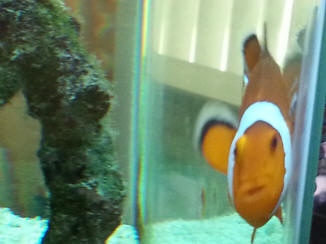
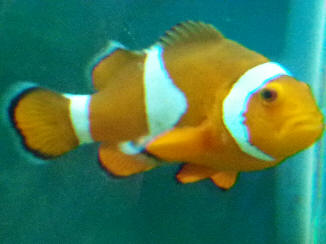 |
|
Re: Popeye on clown
9/30/16
Thank you sir and, as always, much appreciation for your knowledge and time.
Have a wonderful day ��
Kellie Kyser
<And you Kel. B>
So Mote It Be
Re: Popeye on clown
10/7/16
Good morning! Good news! My female clowns' PopEye is completely gone. I wished
to share with you the news of her recovery. Thank you for your insight on
letting her heal naturally. Have a great day ?
So Mote It Be
<Thank you for this update Kel. Excelsior! Bob Fenner>
|
|
Ocellaris Clownfish - sick 9/13/16
Hi,
I have an Ocellaris Clownfish that has stopped eating and swims at the
top of the tank, (about floating) like he is dying but has been this way for
weeks. He is not eating that I can see. His mouth is slightly open, gills moving
more, and his rear fin is dissolving. No open wounds or anything else I
can see. His tank mate is another Ocellaris. They were tank bred and I
got them about 10 years ago. They've been very hardy. Same 30gal tank for that
time.
<Mmmm>
No recent livestock additions. They are fed flake and I picked up some frozen
brine shrimp to try to get him to eat but no luck. He seemed to get excited but
didn't eat. They have eaten frozen before. I had a Six line Wrasse that
died a couple of weeks back. This fish did have a slightly open mouth
for a long time but still ate and acted normal. Not
sure if there is a connection there. Could the Clownfish just be at end of
lifespan or could it be infection?
<Can't tell w/ the data, pix provided>
I'm surprised it's still alive in its present state. It seems blind and
unresponsive to hand movement up to the glass. Occasionally it had swam with its
tank mate like it was getting better but less now...haven't seen that in days.
Makes me wonder if a fish could have dementia and forget how to eat (based on
its age).
I'm attaching a couple of pics. Any idea what this could be?
Thanks, Phil
<Mmm; even w/ cropping and spiffing, can't make out much in your blurry pix.
I'd try a few things here: Supplementing the water and foods w/
vitamins, HUFAs, Iodide (see SeaChem's line for all); placing a unit of
Chemipure in the filter flow path... lowering the spg a few thousandths...
Please do keep us informed as to progress. Bob Fenner>
|
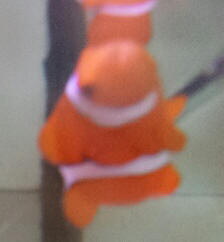
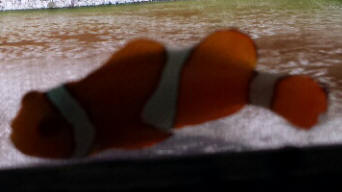 |
|
Re: Ocellaris Clownfish - sick
9/13/16
Thanks for your help!
<Certainly welcome. Bob Fenner>
|
help identify please. 15 megs
4/30/16
Your email has been deleted. Read here:
http://www.wetwebmedia.com/WWMAdminSubWebIndex/question_page.htm
Help Identify please. Clownfish hlth. diag.
4/30/16
Hello,
<Howdy>
So I got a clown on March 2nd. Quarantined for 3 weeks.
<Any prophylactic dip/bath?>
Placed him in my DT that has 1 Duncan, 1 plate, 3 mushrooms,
three polyp frags and Kenya tree. Other livestock is peppermint
shrimp, red legged hermit, blue legged hermit, and neon blue goby. April
3rd color on most rear black line began to fade. Started developing a
whitish color on one side. I was away so my wife went to LFS and
described it. They said it was brook and told her he would die soon. I
got home Monday and he died last night (April 27...almost 4 weeks).
My understanding is brook would've killed him long ago.
<Yes; highly likely so>
So I'm hoping you could help with diagnosing it so I can Quarantine my
goby and how long to leave the tank empty.
you'll see the "disease" or "parasite" or "infection" on his stripe...
Parameters
Nitrate <5ppm
Nitrite 0
Phosphate 0
<Cnidarians need some measurable. See WWM re>
Ammonia 0
Calcium 500
<Too high; see WWM re>
DKH 11
PH 8.1-8.2
Thanks in advanced
<Read here:
http://www.wetwebmedia.com/clndisinfect.htm
Bob Fenner>
|
Help identifying disease 2/20/16
<Seven megs of junk pix... Why didn't our spam filter exclude this mail?>
Hi crew. I got back from a trip yesterday to notice this parasite on the
clownfish and some on certain areas of the Naso tang.
<Trouble>
My mom was taking care of the tank while I was gone. The only thing that I
assume may be the culprit of the problem is the recent addition of a skunk
cleaner shrimp a month ago.
<Sans quarantine...>
I am attaching a picture since I am not sure if it is ich or marine velvet.
Thanks in advance for any help. Frank.
<Or, or, or... Likely Protozoan... READ here:
http://www.wetwebmedia.com/clnfshdisart.htm
and the linked files above: ASAPractical! I would be dropping your spg stat! In
order to save your fishes... You'll need to move either them or the invert.s
elsewhere. You need to READ, and then ACT, NOW. Bob Fenner>
|
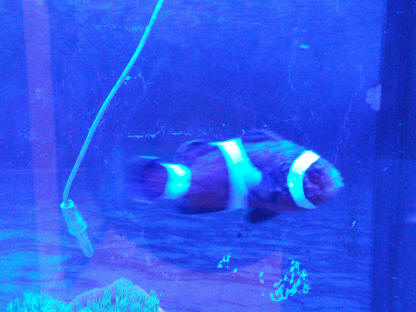
Re: Help identifying disease 2/21/16
Thanks for the response. I apologize for the size of the picture.
<Ah, welcome. BobF>
|
|
Platinum clownfish bruised 2/12/16
<Anas, why not crop your too-large images and just send pertinent data?>
Dear crew members
Just got my platinum clownfish pair tow weeks ago ,one of them developed 5 days
ago a dark shade on one side of the body not red more like black violet
,a bloated belly for tow days without eating thought it's constipation, gone now
but the shades still exist still not eating, all parameters are great except
the nitrate a bit high,
<? How high is high?>
please check attached photo
Need help, thanks in advance
Best Regards
Anas
<Likely just stress, the NO3... Read on WWM:
http://www.wetwebmedia.com/clnfshdisart.htm
and the linked files above. Oh yeah!
Bob Fenner>
|
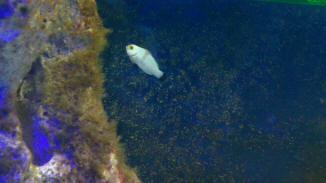 |
|
Clown Fish; hlth.; env. 2/4/16
Hello,
I’m wondering if you could help me?
<Will do my best; as always>
I’m new to this hobby. I have a newly cycled 65 gallon tank with live rock, one
coral, some snales/hermit crabs and two new clown fish. Bought them a week and a
half ago. My water tests are all good. PH 8.4, Ammonia 0, Nitrate and Nitrite
are 0.
<No accumulated Nitrate? Odd>
I did have an issue with the gravity as I had a faulty hydrometer and had to
lower it from 1.30 to 1.25. I noticed that my clown has been pooping a white
stringy poop and recently I saw a white speck under his eye. He is swimming
around and eating fine. Wondering if anyone can identify what it might be? I'm
posting pics.
<Can't tell from your images or writing what is going on here. Could
well be that the too-high spg is all that is causing the marks here. I would do
nothing other than read for now. See WWM re Clownfish diseases>
Thanks!!
Jay
<Welcome. Bob Fenner>
|
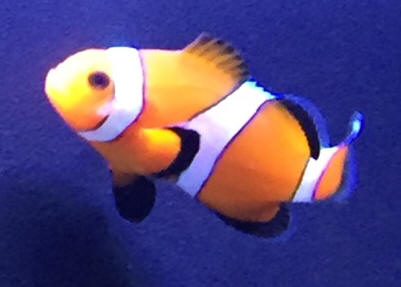 |
|
Re: Clown Fish 2/4/16
Thank you, actually when i came home today the mark was almost gone.
<Ah yes; good>
Thanks for your help
Jay
<Welcome. BobF>
|
|
Disease Identification: Black Clownfish
1/26/16
Hello, I recently noticed one of my black Clownfish has what appears something
developing on its face. I've included a photo.
<Yikes...>
It appears to be discolored and a portion of it is raised. I have a concern it
is a fungus or a parasite. Are you able to discern what it is from the image?
What would your recommend?
<Mmm; well; this might be Uronema; other protozoan... or... I'd be sampling and
looking under a microscope ahead of trying actual treatment/s. Bob Fenner>
Thanks so much for your insight.
Brent Wells
|
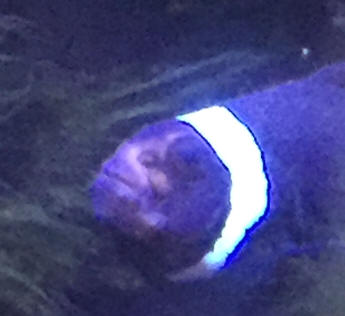 |
|
Sick GSM clown?? 1/22/16
Hi, its been a long time since I've had to come here. Glad to see your <sic> all
still around......So.... Tank, 90 gal, 20 gal sump. All water parameters are
spot on, salinity at 1.023. Fish are 1 Picasso trigger, 1 Niger trigger, 1
porcupine puffer, 1 domino damsel, 1 GSM clown, 1 LT anemone, 1 coral banded
shrimp and some turbo snails, all of them I have had for over
a year except the GSM.... The 2 triggers and puffer are around 3in each the GSM
is about 2.5in. I just got the GSM about 2 weeks ago not sure if its wild or tr.
<The former... this fish was quarantined, treated ahead of placing?>
Just yesterday I notice his fins all have some black markings on them that I
don't really remember seeing before and I'm seeing a little bit of white one
them in some minor spots (see pic). She seems just fine, eats and swims fine but
I would hate to lose her and just wondering if you might know the problem. I've
searched all over and can't find anything about black fins on GSM. Thanks... Oh
also on a side note the GSM and the CBS almost seem like there trying to mate.
The GSM will back up to the CBS and just kinda nussle back into the CBS and the
shrimp just kinda puts its arms around it, last night I did see them in the same
position only the CBS had a light hold on one of the GSM fins and was kinda
slowly walking her back to his cave. It was very gentle and the GSM didn't seem
to mind at all.... Ever heard of this activity before?!?... Thanks again. I
posted a gif on imgur if you would like to see the weirdness between the two..
the black on the fins don't stand out much in the pics but you can see
the white it is definitely noticeable irl..
http://i.imgur.com/HnqMmkw.gifv
<I do see it, this. Might just be excessive mucus... but from? Getting
to know the LTA? Harassment by? Perhaps Uronema; I'd be reading on WWM re the
latter. Bob Fenner>
|
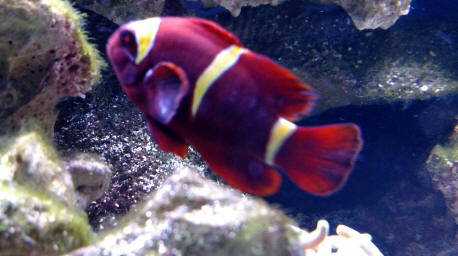 |
|
re: Sick GSM clown?? 1/22/16
Thanks for your quick reply as always, I did quarantine the fish for about 8
days in a 30 gallon with the anemone. They were bought at the same time but were
in different tanks, Iv never had a problem before from my lfs that's why the
short quarantine and they were both doing great and looking great..... No one in
the tanks messes with him at all (except the romance from CBS lol), actually the
tank is very peaceful for an aggressive tank.... I have had a SW for over 18
years now and never even heard of Uronema and OMG I hope that's not it now that
I've read a little and seen some pics.... I guess I should get them out now and
back into the Qt.
Thanks
<Maybe all will resolve on its own. Elsewise, I'd give a good long time (a
couple mo.s) before buying another Amphiprionine. BobF>
|
|
Mystery Lesion on clownfish 1/20/16
On Tue, Jan 19, 2016 at 4:23 PM, Robin T wrote: After reading the WetWebMedia
site for several years, and today seeing your response to something similar on
the side of a another clown, I thought you might be interested/have some insight
on the lesion we are trying to resolve on my female clown .
<Yes; please>
In August I noticed a small red lump on her left "nostril". A flattened clear
tissue soon developed on it but it all resolved within 2 weeks.
8 weeks ago the red lump reappeared in the exact same spot, followed by a clear
bubble. She continued to eat and act normally but spawning behavior and egg
laying ceased. I took pictures to my LFS and posted on 2 forums without results.
2 weeks ago the bubble grew large enough to alarm me. I moved her and her mate
(since they have never been separated since they were purchased as juveniles in
June 2012) into a 5 gallon hospital tank.
After the move the bubble disappeared (ruptured in the move?) but the lump
remained. I did a complete round of Maracyn 2, then ran poly-filter and changed
50% of the water, and a day later started Furan 2. The bubble began to reform
and during the last 2 days of treatment she refused all food. I changed their
water and reacclimated them to the biocube water, then moved them back. Within a
hour or so she began eating voraciously again. The lump now appears more ragged
with pale areas when zooming in on pics.
<Ahh!>
She and her mate are the only fish in in biocube 29, along with a few snails. He
has never shown any symptoms. There are soft and LPS corals (mainly Euphyllia).
Nitrates run around 25 due to heavy feeding of a sun coral, despite running a
Tunze skimmer, media basket with carbon & Purigen, changing filter media daily
and 20% water changes weekly. All other
parameters are within normal ranges. Salinity 1.025. We feed mysis, Reef Frenzy
and NLS pellets on a rotating basis, soaked in Selcon 2 to 3 times a week.
The first pic is from 3 weeks ago before treatments, the second from today.
Thank you in advance for any ideas or suggestions.
Robin Tingley
<Mmm; well; can't say where the initial "cause" lay here... perhaps a physical
injury, maybe a bad-enough sting from the Euphyllia/s... and some sort of
secondary infection (bacterial?) or a reaction event from w/in the fish itself.
Your good care and poss. element/s of the treatment (the Furan is my guess)
turned the balance to the host/fish.
Thank you for sharing. Bob Fenner>
|
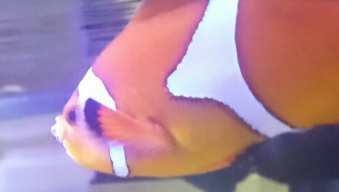
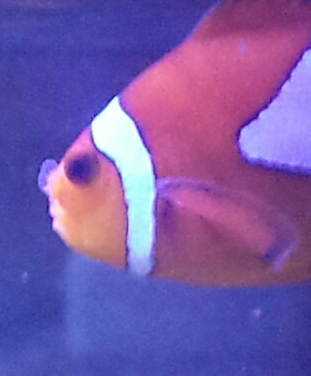 |
Help please. Perc hlth. in a new sys.
6/27/15
I bought a tank raised percula 4 days ago it will eat very little but does eat
and has been breathing rapidly since acclimation. It is the only fish in a newly
cycled 30 gal tank I have 5 Ceriths 4 mass and 5 hermits. The tank has been
cycled for 2 weeks with a pH8.2 amm 0 nitrite 0 nitrate
<You should be registering accumulated Nitrate>
0 SG
<Mmm; no>
1.025 and temp 80
<Lower this to the mid 70's F>
I have 20 lbs of live rock and a refugium with Chaeto.
What could be causing the rapid breathing. I've also got a pH aimed at the
surface for added surface irritation.
<Agitation... Likely there are some chemical issues; yes, even though this
system is cycled... I would add some activated carbon of quality to your
circulation, lower the temp. and naught else here. Bob Fenner>
|
Fish 911 please help.... no data,, or use of WWM
4/30/15
<Six megs of pix and no reading? SEE/READ on WWM re clownfish Trauma. Bob
Fenner>
I've had a clown fish for a day with a small abrasion that's turned into this in
one day please respond to
vinayXXXX@gmail.com
|
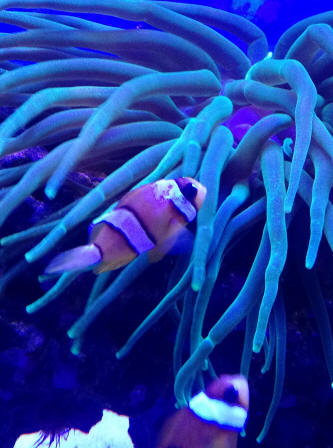 |
|
Strange Maroon Clownfish Death/Issues. Diag.; shooting in the
dark 2/27/15
So long story short. I started my 90G tank in August of 2014, went
through the normal cycle, added fishes, hooray for me I'm a hobbyist.
Then a few months later, disease struck because of no QT, lost 3
fish and rehomed the other two to begin my fallow period.
Started a cycled QT at the same time and after that cycled, proudly put
in two maroon clownfish that I was able to bond and they spent a happy
six weeks in QT (only med was PraziPro). On Saturday I started TTM with
them (backwards yes, but I planned copper originally and changed my
mind). Monday morning I notice a little white film on top of the small
one's head
and Tuesday morning he is dead. Monday night he looked fine so I
thought. His breathing appeared a little rapid, but seemed normal like
it had the last 6 weeks. Larger one was breathing a little slower but
also what I had observed for 6 weeks.
Carcass showed nothing else on the outside. No film, tears,
cuts, abrasions, rot, no nothing except a dead fish.
<... sampling, microscopic exam.? No>
Transferred the living one to the new bucket today and now she won't
eat.
Breathing is appearing to be a bit quicker than last
night. I'm using an airstone and pump rated for 10 gallon tanks and the
water was made up over a week ago. Only thing added was ammo lock on day
2 and the next day they quit eating. No ammo lock was put in the second
bucket.
After a day in that bucket, I saw she was getting worse. I took her out
and put in her my DT as a last ditch effort to save her. That was
Tuesday night and now here on Thursday she's making progress and is
eating again.
Swimming better and breathing has slowed down but is fast. Here are some
images and video. You can see some whitish stuff coming out of the
gills.
It has lessened but is still there today.
http://i174.photobucket.com/albums/w100/rf_fanat1c/FD47D7A7-8511-4901-95E3-47D1BA31172A.jpg
<... poss. flukes; maybe just med. exposure.>
Night put in DT right after coming out of bucket.
http://youtu.be/H300kHZ1hvI
24 hours later http://youtu.be/xxW5Xv-QhJc
<... the same, ditto...>
Buckets were temp, ph and sg matched. 76,8.2,1.024. Both were fine and
healthy until I started TTM. Qt did have a cloudiness to it the last
week they were in there, suspected bacterial bloom from over feedings.
Qt was 37G but they spent all their time in one corner but were healthy.
They were also not wild caught, but captive bred. The larger one had
been at the fish store for 6 months and the smaller one for a month.
<Could've picked up something from other livestock there>
People on the forums are stumped as well as am I. Thanks for any help
you can provide. I enjoy your site.
Jon
<The 'scope... reading, perhaps an e-copy of Ed Noga... Bob Fenner> |
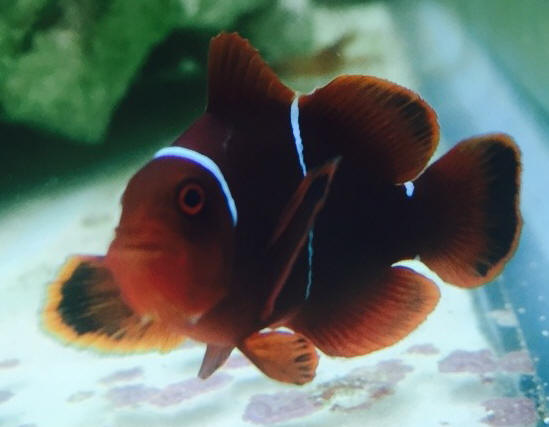 |
|
My clown has a hole in it. So does this relating
2/10/15
Over the last couple of days i noticed that one of my clowns (mocha
ocellaris) is less active and mostly sticks to the patch of hair algae
that hi picked as a host. When i was feeding the fish today i noticed
that he ate very little. So i started watching him closer. I noticed
that his left side has a dip in it in the middle white stripe. The dip
has some small holes in it. The same clown had a similar thing happen
before but there was no problems with appetite or any change in
behavior. And he healed
completely without any interference on my part. This time I'm worried
that he isn't eating and is not as active as normal. The previous time i
did a large water change and that's it. But i just did a large water
change about 3 weeks ago and all the parameters are still within norm.
All the corals
<What species here?>
are blooming and there are no other sick animals in the tank.
So the question is. What exactly is with my clown?
<A guess from the scant info. provided: It's been, being stung by one of
the "corals"; or possibly chewed by a Bristleworm, crustacean
hitchhiker... >
And what could possibly cause it if it isn't the water quality. And most
importantly how do i cure him?
<Let's have you read; here:
http://wetwebmedia.com/marine/fishes/FishInd2.htm
Scroll down to Clownfishes; Disease... need better, more data.
Bob Fenner>
Re: My clown has a hole in it.... Still not rdg., following directions
Induced Cnid. Allelo. troubles
2/10/15
I got hammer head coral, zoos, mushrooms.
<Any of these...>
acropa, a green bubble tip anemone,
<... not a good idea to mix... READ on WWM re Actinarian/BTA
allelopathy>
Galaxea,
<... Oculinids... at the height of stinging-ness>
Acan. And one with one more that i don't remember what it is but it has
about a hundred tentacles that come out and they newer get more than
about an inch long so not allot
<...>
of reach. I got a bunch of dwarf hermit crabs and a strawberry
crab.
<And these>
Stow aways are unlikely. All the rock i got in the tank is the same that
i had from the beginning. I do have bristle worms but i haven't seen any
large enough to take out that large of a chunk. And why would something
nip it in the same spot with several month in between? But just incase
That's a picture of the one coral i don't remember the name of.
<A Faviid of some sort>
Any other information that would help?
<READING... re the above... and where you were referred to prior. DON'T
WRITE, READ. BobF> |
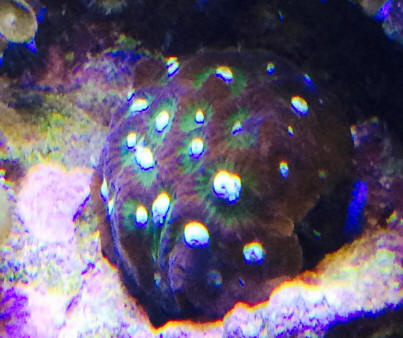
Do you see what I see? |
Quick Question 10/24/14
Bob,
Hope all is well. I just bought your book a few months ago on sea
anemones. Thank you as it as helped me in the health of my sea
anemones.
They might have wasted away otherwise. Quick Dip question:
<Okay!>
Purchased four aquacultured clownfish, Spotcinctus Clownfish, Slow
dripped acclimated them and put them in a 40
gallon QT Tank. Question 1: From what I have
read on WWM one of the posts states that Amphiprionines should
not get a freshwater dip upon initially receiving them? Is this
correct?
<Usually unnecessary; particularly with captive produced stock
(shouldn't have any issues, parasites that such a procedure would help;
but...>
If not they are already in the QT tank; what next steps should I take?
<Move to permanent display>
Should I freshwater dip (pH and temperature adjusted) to the main tank
when
the QT period is over?
<Not UNLESS there's something obvious that calls for dip/bathing>
I have some Nitrofuracin green from NFP. Would
this be a good preventative if I was supposed to freshwater dip (pH and
temp adjusted) before putting in the QT?
<Mmm; no; not really. Not enough "gets inside" dipped fishes in such
short durations>
I guess I am trying to understand if I made a
mistake, and if I did what do I need to do to fix it.
Best,
Nick
<No worries Nick. Bob Fenner>
Part 2 of clownfish
question 10/24/14
*Just an fyi I did read the below summary, and that's where I found the
discrepancy on freshwater dips, and wanted to know about the
Nitrofuracin
green. Best,*
*Nick*
*Treatment: Prevention, as usual, is the rule.*
1) Pick out reasonable stock as detailed in the selection of this
article.
2) Do a brief freshwater dip to remove some/most external grunge (a
scientific term).
3) Quarantine your new stock if at all possible/practical with or
without
their anemone for a couple of weeks. Using a mild bacterial medication
is
suggested; Maracyn II (tm) is excellent.
<Erythromycin? Who wrote this? Can you give me the location of this
citation?>
4) Introduce them to their new viable, permanent aquarium. After
acclimation, add a "slime-coat" water conditioner.
Note: If you can't procure quarantine quarters, ask your retailer to
hold
your charges for you on deposit.
If you find yourself with clownfish with an apparent
infection/infestation
that seems to necessitate treatment:
1) Check and adjust your water quality. Most "disease" conditions of
captive aquatic systems are a result of poor water or system quality. Do
not just start pouring a therapeutic into your tank(s). Often, moving
the
clown's to a different system effects a fast "cure".
<Yes>
2) After quickly doing whatever you can to "re-center" your system,
consider further treatments in the following order of priority:
A) Biological: Add a symbiotic anemone if you don't have one or move the
fish/es to a system with one. Add a cleaner; a suitable Labroides wrasse
(if you can secure a "good one" that has survived the rigors of capture,
movement, acclimation to captive conditions), or better a cleaner goby,
cleaner shrimp; they work.
B) Physical: Lower your specific gravity. Even with most invertebrates,
dropping the specific gravity a few thousandths per day to 1.018-1.019
will
not do permanent damage and may shift the balance of favorable
conditions
to your fishes.
C) Chemicals: Last and least. Be careful. Clown fish are like "canaries
in
a cave". They tend to be sensitive to the same toxins as their host
Actinarians (anemones). Copper, other metal salts, organic or metallic
dyes, furan compounds, and organophosphate pesticides all have
deleterious
to disastrous effects. These substances in various formulations,
comprise
most of the "medicine treatments" available and used in our aquatics
interest. They do have some limited, appropriate applications in bare
marine treatment tanks. 'Nuff said?
<Reads like summat (word order, use) I'd write>
These chemical therapeutics are dangerous and unnecessary with
Clownfishes.
"Experiment" with them only as a last resort.
<Cheers, BobF>
Re: Part 2 of clown fish question 10/25/14
LOL you wrote it. Here is the link
http://wetwebmedia.com/clnfishart2.htm
<Well; just goes to show. From the ref.s looks like it was penned in the
mid 90's. Don't know what I was thinking of re the Mardel product...
Thank you. BobF>
|
A couple questions! Clownfish
disease concerns bordering on.... Crypt, lumenal parasites?
8/5/14
Hi crew,
Long time fan, I really appreciate all that you guys do around here.
Please excuse me if these questions have already been answered, but I
have tried to use the search function to no avail. I believe my
questions are a tad too specific.
<Let's see>
I currently have 2 clownfish in my QT, and I've just finished the 4th
transfer using the tank transfer method to prophylactically treat them
for Ich.
My QT is a 20 gallon tank, currently sg is hovering around 1.025,
temperature is at 80-82 degrees. All parameters are in check, as the
fish have only been in the water for 3 days so ammonia is at 0,
nitrate/nitrite 0, pH. around 8.0-8.2. I have also been dosing with
AmQuel plus, to make sure to detoxify any possible ammonia.
I just have a couple questions regarding the health of my fish before I
throw them into my display:
1) One of my clowns has ONE "dot" which is white, on one of his pelvic
fins. Now this "dot" has been there for about 4 days, and hasn't
expanded/multiplied or changed in any way.
Is it possible for ich to show up as only ONE dot?
<Yes; but unlikely. This spot is probably "consolidated body mucus" from
general stress>
and remain that way for up to 4 days? I have a feeling this isn't ich,
but rather something else, possibly an injury?
I THINK it might just be a "hole" because when I look at the pelvic fin
from the other side as well, there seems to be a white dot on the same
spot, but it's weird to think that he found a way to make a "hole" in
his
fin, rather than a tear. If it were just a single Ich spot on his fin, I
wouldn't see the same white dot from BOTH sides of the fin, would I?
<Could; yes>
Would ich behave in this manner at all?
<... again; not likely>
I'm thinking if it was ich, it would have multiplied by now, or fallen
off, or changed in any way, or the fish would show signs of the disease,
breathing heavier, flashing, appetite loss, anything. The fish has not
changed his behavior in any way. Still eating like a pig. Currently I am
only feeding them the Thera-A new life spectrum pellets. I'll add more
variety to their diet once they're in the display.
The other clownfish has shown 0 signs of ich, no dots, nothing.
Any ideas? am I just being paranoid?
<The latter>
My second, unrelated question:
2) The other clownfish has weird stool patterns. Sometimes he has really
long, stringy white poop, similar to that of an internal parasite.
Please find attached a picture of the poop that I saw a few days ago.
<Again; most likely "just" stress... You could look at a specimen under
a microscope...>
Now this poop looks very similar to what an internal parasite looks
like, but both of my fish have gone through a PraziPro treatment, twice.
The clownfish will show this poop one day, and then the next day he'll
have somewhat "normal" poop, which would not be long white and stringy
like pictured. He has continued to have normal poop for the past 2-3
days, which is the strange part for me.
Is it normal for a fish to show this type of stool one day, and then
seemingly normal stool the next day? It seems like he'll go a week
without showing stringy poop, and then one random day he'll show it for
a day or two and then go back to normal poop. I was under the impression
that if it were internal parasites, then the fish would continue to show
stringy poop until the parasites have been cleared. Not show stringy
poop one day, and then normal poop the next. Am I mistaken here?
Do fish get different poop from stress?
<Yes; same as humans>
He showed the stringy poop right after the 4th tank transfer, and then 1
day later, he had normal poop again, so I'm thinking is it possible for
his stool patterns to change simply due to stress? or diarrhea? haha.
Any ideas?
I want to throw my fish in the display in a couple days, as they seem
healthy and happy, but I'm just worried about these two issues right
now, which makes me doubt if they are 100% ready.
Any input is much appreciated.
Thank you very much, and enjoy your day.
Cheers,
Fahd.
<Welcome. Bob Fenner>
|
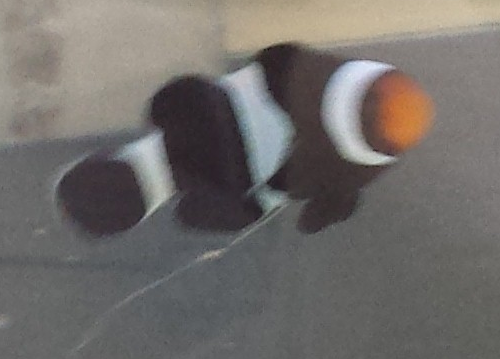 |
Clownfish keep dying 1 always lives... "The butler-fish did
it" 7/4/14
Ok so im new to the hobby first time on this forum posting. Been reading
it for about a year before I got the tank (I do ALOT
<Mmm, no such word>
of research before I get into something like this) but let me get into
my problem and its not a mantis shrimp I always find the bodies and take
them out the bodies don't stay in for more than a few hours and I always
wait a few days before getting another fish to check levels
Hi guys my aquariums is as follows (sorry if my spelling is wrong
on anything)
75gallon set up for about 2 months now
about 80+/- lbs live rock
60lbs live sand
Fluval 405 canister filter
SeaClone 100g skimmer
temp 78-80 bad heater need a new one (temp fluctuation is not bad it
just creeps up and down over a week or so never above or below those two
though
48" Odyssea t5ho lights 2 10k 2 actinic
Param.s
1.021 sg
0 ammonia
0 nitrites
5-10 nitrates
15g water change every 2 weeks
fish list
1 snowflake ocellaris 2" +/-
1 lawnmower blenny
1 neon Dottyback
1 six-line wrasse
<... could be the one Ocellaris, the Pseudochromid or
Pseudocheilinus....>
1 diamond watchman goby (sits at bottom eats sand all day) lfs said
that's what it was but heard there's two different ones that look like
that
1 neon goby
inverts
1 skunk cleaner shrimp
assortment of turbo Astreas and 2 other kinds of snails
I think they are blue legged hermit crabs maybe 10 to 20 they come in as
hitch hikers I bout maybe 5 and they either hitchhiked or made behbehs
lol
and one 2" Bubbletip anemone its been in there for about 3 weeks now
originally got it for the clowns but then it moved to the very back of
the tank where I didn't want it like they tend to do so I hear lol
anyways my problem is I've had the tank running for about 2 months now
since may 26 2014
I started out with 2 clowns after the tank got done cycling the first
time no fish just a table shrimp in it for a week then out one clown
died due to second cycle is what lfs told me I added 2 domino
damsels and the neon Dottyback 1 damsel died in first 24h second damsel
died 1w later
<!? Usually VERY tough>
added lawnmower blenny and sixline wrasse 6 line jumped out and died 2
days after I got it cause I forgot to put lid back on added another one
and the diamond watchman goby added another clown it lived about a week
and was doing fine then died added another clown it died added
another clown it died
<Killed>
went to one of my buddies he's been doing marine for about 12 yrs he
told me that my clown might just be really aggressive and killing my
other clowns so he told me he'd give me store credit if I bought a pair
of clowns from his tank so I did that I get them put them in my tank 4
days later one of them kicked the bucket now im back to having just one
clown again and all other fish are still alive
But here is clown types all ocellaris that have died
1 false percula
1 misbar false percula
1 extreme misbar false percula (almost a naked clown only had a tiny bit
of a white spot on its gill maybe a 1/4" wasn't ick either lol
1 snowflake clown
im sorry this is so long but I really want a clownfish couple don't care
if they breed just want a pair of them and a anemone for them I know
clown/anemone hosting takes time but I think its cool to watch
<Am sorry I didn't return this mail to you to fix the grammar>
also acclimation procedures I've tried have been Float and drip then
transfer fish only
float and drip then pour bucket into tank
float then transfer
Float then pour bag into tank
what im trying to figure out is why only one of my clowns dies even when
I put them in as a pair and the other one doesn't is there anything I
can do that im not doing to prevent this or am I doing this properly and
its just the fish being weak and stressed to badly to the point of death
and sorry if this should be put somewhere else I couldn't find a clown
only section so I figured itd go good here lol
<... See above... my bet/guess is on one of the stated fishes as/are a
bully. Bob Fenner>
Re: re: Clownfish keep dying 1 always lives
7/4/14
Also something I forgot to say what that 2 of the clowns that i saw
before they died were breathing really hard I've been told its called
gilling not sure though and are at the top of the tank like a gold fish
or Betta in a fresh water tank getting air but I have 2 Koralia 1150
powerheads in the tank causing water ripples at the top not sure if that
has anything to do with them dying and im just not sure as I didn't see
the other 2 doing it out of the 4 that have died just 2 of them did it
<More poor English and yet more evidence of bullying. SEARCH/READ on WWM
re such. BobF>
Re: re: Clownfish keep dying 1 always lives
7/4/14
And also when I thought it was the one ocellaris my buddy told me that
also so I took it to the store and got 2 completely different ocellaris
<More victims. B>
Re: Clownfish breathing rapidly after feeding
– 06/18/14
Hello Sir,
It's been about 6 weeks since we last chatted. After taking your advice
regarding switching out the flake food that I had been feeding her,
there was a vast improvement in her condition.
<Ah good>
The rapid breathing, scratching, coughing and darting had diminished by
about 70%. Unfortunately, she has
been stuck at this 70% level for the last 5 weeks. The other issue I've
noticed is, for the last 6 weeks, her skin has had this whitish, shiny,
almost glazed appearance, when the light hits her at the right angle.
I'm
assuming that this is excess body slime.
<Could well be>
There appear to be little pustules on her body as well, as if she had
Ich or Marine Velvet
<IF this the fish would assuredly be dead>
but they are not white, tan or gold, they are clear like the slime
itself and they've been there for the past 5 or 6 weeks. Her eyes have
remained clear and her appetite has remained very strong. I don't know
if this is just a reaction to the stress she's been enduring or a sign
of some other disease or infection. All I seem to find when searching
"excessive slime on marine fish" is Brooklynosis, which I don't think it
is because she'd be dead by now.
<Yes>
All my other fish have remained healthy with no issues. ( Please add
words of wisdom between these " < > " thingies. ) Thanks, Art.
<Heeee! Welcome Art. BobF>
Black clown prolapse? 6/2/14
Hi can you please give me advise my clown fish laid her eggs two
days ago as usual and for want of a
better description it looks like her uterus has
prolapsed it's hanging down still and she is clearly distressed
taken refuge under the anemone and seems to be
breathing quickly panting. Please can you
offer me some advise I have had her mate for seven years and don't want
to loose her :-(
Kind regards j x
<This "does happen"... and for the most part, most times, self-repairs
in days... There are some folks who advance the use (addition) of Epsom
Salt... you can find coverage re this on WWM (the search tool on every
page). Bob Fenner>
J to Bob Fenner black clown prolapse 6/2/14
Thank you Bob for your quick response iv been so worried iv never seen
this happen before so thank you again for your advise
Kind regards J x
<Ah, welcome. BobF>
Clownfish breathing rapidly after feeding
5/5/14
Hello, I am currently experiencing a 3 week long problem with my 7 year
old female Ocellaris Clownfish. Whenever I feed her, minutes
later, she becomes semi-listless and she starts breathing rapidly.
<Mmm; wonder... some sort of gut blockage? What do you feed?>
It appears that her left gill plate stops functioning while the right
one is pumping away at high speed. This usually lasts for about 1 to 2
hours and then it slowly goes away and she starts swimming around, more
and more, like normal. There are no signs of external parasites, cloudy
eyes, sores or any other physical abnormalities and her appetite is
strong and she has continued to lay eggs. My other 2 fish seem to be
fine, at this stage. All measurable water parameters are excellent in my
display tank, however, I decided to put her into a hospital/auxiliary
tank to see if maybe there was some sort of unseen toxin in my DT that
was bothering her. Unfortunately, the problem has not gone away. I also
gave her a freshwater bath( un-medicated ), but it did nothing to help.
She doesn't do well in a FW bath. I have dipped plenty of fish before,
usually for 5 to 10 minutes, with no problems. She, however, gets very
stressed after only 3 minutes, so that was all I could do with her. I
don't know if this is some sort of gill fluke or an internal parasite or
something else. Any ideas and a plan for action would be greatly
appreciated. Thank you, Arthur.
<Well; there are times, not uncommon where fishes will breathe more
quickly, and only apparently one-sided. Again; the foods...
Bob Fenner>
Re: Clownfish breathing rapidly after feeding
5/6/14
Thanks for your quick response, I feed frozen Mysis and brine shrimp in
the morning and herbivore flakes in the
evening.
<Mmm; these should be okay. I'd switch out a good quality, small sized
pelleted in the stead of the flake for a few weeks...>
This is what I have always fed them. I forgot
to mention, that along with the listlessness, there are also
other signs of stress like some scratching, darting and something that
resembles coughing. Thanks.
<Am now thinking it/this may be "something else" the Clown ate, is
eating... like small worms, mollusks in the system... that it can't
quite pass. Perhaps the addition of a modicum of Epsom salt will help
here. Bob Fenner>
Re: Clownfish breathing rapidly after feeding
5/6/14
Thanks Bob, there are hundreds of little white snails, about
1/16" in size, crawling around my live rock
and tank.
<Ahh!>
I do see her often picking them off the rock
and glass whenever they get too close to her eggs. I have never
seen her eat one, but I suppose she could have eaten one, by accident,
in the eviction process. I would like to try
the Epsom salt, so please tell me how much and
for how long. Thank you, Art.
<Please just search on WWM... too much to re-key. Cheers, B>
Re: Clownfish breathing rapidly after feeding
5/10/14
Hey Bob, I added the Epsom salt to the hospital tank, but I have not
seen any improvement yet. She seems to be
stress out, now, all day. She spends most of
the time laying on the bottom, moving/darting from corner to
corner. The scratching and coughing happens all day now , not just after
feedings. Her breathing is at an elevated rate most of the day
now, too.
She, usually, keeps all her fins, clamped/lowered, with the exception of
her pectoral fins, which are very active.
<This last behavior is fine, natural>
The only time these conditions change is when
I feed her. She will perk right up and you'll never know
that anything was bothering her. Her appetite still very strong.
I have noticed her producing white stringy
feces recently. She has done this from time to
time over the years so maybe it's just coincidence that it's
happening now. The other odd thing I've noticed was sometimes
when she " does her business ", along with the
white feces, air bubbles come out.
Yesterday, during one of her coughing spells, she actually coughed up
air bubbles. This I have not seen from her
before. Any ideas? Thanks, Art.
<Mmm... more reading... and patience. Take the long view on WWM re
Clownfish Disease (articles and FAQs). B>
Poorly clownfish
Hello WWM crew!
<Jenny>
I desperately need some quick advice on how to help my poorly clownfish.
<I see your pix... the Clown; mouth open-ish... PVC pipe, a questionable
stone>
I’ve had him in Quarantine as a new purchase for about 6 weeks.
<Appears to be a wild-caught specimen... Why not a cultured one?>
After around 4 weeks I noticed a faint white spot
<Single. Of, by itself, no need for real concern>
on his flank so he’s been under Cupramine treatment for 2 weeks. The white
post is still there leading me to believe it is not Ich as it hasn’t
moved/disappeared at all after/during treatment. It is still only very faint
but I have now noticed a few more under his jaw.
<Likely just body mucus accumulating about Neuromasts>
Yesterday I dipped the fish in Sera Tremazol (uk anti worm-flukes med) for
30 minutes (longer than the 20mins recommended because I was cleaning his
tank while he was in there and it took a little longer). I figured 30
minutes would be fine as the recommended bath is the same dosage for 6
hours.
Anyway, I moved him back to his newly cleaned QT after this and he seemed
fine – eating and swimming around until later in the evening (perhaps 3hours
later) and now he looks very unhappy. His mouth is slightly opened
constantly (as per picture – white-spots not visible on camera). He is just
floating around near the bottom of his tank whereas before he was up and
down in that adorable clownfish fashion. He is also no longer interested in
food. I’m also pretty convinced I saw him vomit – is that even
possible!?!?!?
<Yes; likely just the dip/bath procedure>
It could’ve just been regurgitated food he’d been chewing but I saw this
while he was showing no interest in food.
I found the small filter I have in there failed overnight when we had a
power cut. I had to go to work so didn’t have time to fix it but did manage
to add a tiny powerhead near the surface of the water as I thought (I hope!)
that it’s just lack of oxygen!?! Does this sound feasible??? Do you think I
could’ve given him to much medication in quick succession (the Cupramine
followed by sera Tremazol?).
<No; I would not... six weeks in isolation...>
Can you recommend anything I can do if I Have over medicated him? I’m really
fond of him and was looking forward to moving him and my other clown (in a
separate QT) into the DT this weekend. Please help me!!!
<I would (simply) move this fish to the main/display at this point; perhaps
through a one minute dip of pH-adjusted freshwater. It is unlikely it has
any pathogenic disease at this juncture, and delaying here will result in
its demise. Bob Fenner>
Jenny |
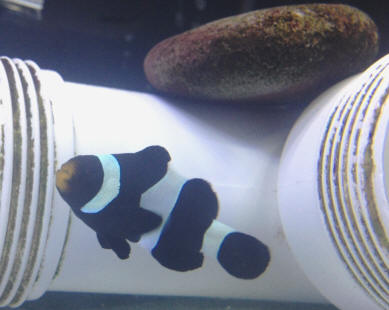 |
Re: Poorly clownfish
Bob,
<Jen>
Thank you so much for your response. I am on my way home to transfer him to
my main tank now as per your advice. If he continues to look like this - do
you have any suggestions on what I should do?
<Stay observant for now...>
I am going to do a short FW dip before he goes in. He was sold to me as tank
bred. Is this not the case?
<Can't tell from here... but larger, well-colored specimens... Lo dudo.
BobF>
|
Re: Poorly clownfish 4/23/14
Bob, just wanted to say a massive THANK YOU for your advice. As
expected, you were spot on and I now have a very happy pair of clownfish
in my display tank. You have also advised me on my other clownfish who
suffered a colour change due to copper treatment. You have helped me no
end - I'm not sure Mona and Monty would still be here if it wasn't for
you! Can't thank you enough!!
Jenny
<Certainly welcome. BobF>
|
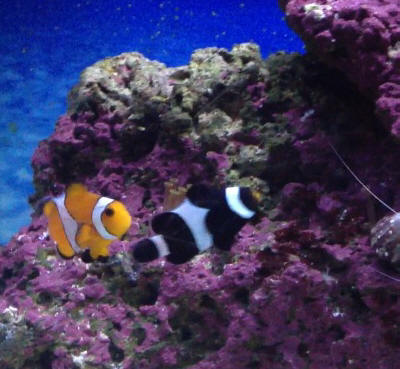 |
|
|
Strange growth on clownfish
4/3/14
Hi,
<Leah>
Do you know what this strange growth on my clownfish might be? It
started out as a black dot under his mouth and within a week it now
looks fuzzy.
Any ideas?
<... the pic is a bit blurry... But am given to speculate that this may
be an Isopod... Do see here:
http://wetwebmedia.com/ClnCrustDisF.htm
and here:
http://wetwebmedia.com/isopoda.htm
and the linked files above... can be more/less (gently) removed w/
tweezers; holding the fish gently in a net underwater>
I really appreciate any advice you might have. I'm new to saltwater
tanks and none of the pictures on the net quite look like this.
Thanks
Leah
<Welcome. Bob Fenner>
|
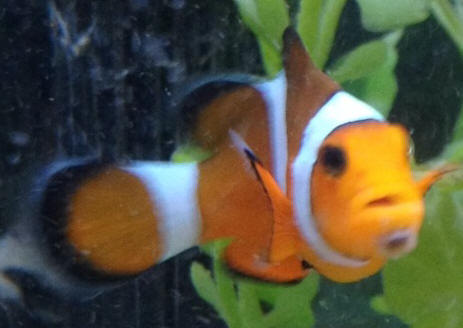 |
|
Re: Strange growth on clownfish
4/4/14
Thank you, I'll try that : )
<Do report back. Gracias. BobF>
Re: Strange growth on clownfish
4/5/14
Hi Bob
<Leah>
I netted him and was about to remove with tweezers but On closer inspection
it wasn't an isopod. Looked more like Lymphocystis (highly likely as I'm new
to this and have no idea what I'm doing) so am going to treat with better
food and improved water quality (nitrite levels 2.0 too high)
<Yeeikes! Nitr"I"tes?... Yes; any is too much>
The little guy is in quarantine and my fingers are crossed. I'd hate to
loose <lose> him as he has loads of personality.
Thanks again
Leah
<Welcome. B>
|
|
Clownfish with ICH, just using WWM
3/20/14
Hi!
<Meli... the little sweet one>
I just started my salt water tank a little over a month ago this past
Sunday ( 3/16/14) I added two clownfish, 5 snails and 10 little hermit
crabs.
<A note: I would not add all these at once>
The day after I added everything to the tank my clownfish developed
white spots and it's looking like ICH.
<Does indeed>
One fish has it worse than the other I attached a picture of one of the
fish. I bought the PH test and alkalinity test and my ph looked fine but
my alkalinity was low (2.5). I bought the garlic guard food
<... of no use>
but my fish still won't eat. Is there anything I can do to help heal him
or prevent any other fish I add to the tank from having this?
<? Read here:
http://wetwebmedia.com/clndiscrypt.htm
and the linked files above till you understand, decide on a given path>
Thank you in advance for your help
Melissa
<What we do. Bob Fenner>
|
.jpg)
Re: Clownfish with ICH 3/20/14
Thank you for your help! The place I bought them from keeps throwing new
things I need to buy at me instead of helping me with the problem
<Ahh, the merchant-mind affliction>
so its nice to get some good feedback! What would you recommend I do ?
<Read; and quick. This fish is near its end>
I purchased ParaGuard ( SeaChem brand) they told me to do two treatments a
day until I see improvements
<This product might work; IN a separate treatment system. BobF>
RE: Clownfish with ICH 3/20/14
I've been reading and I'm just so lost with all of it, Im fairly new to all
this so its all confusing
<Ahh; easy to become overwhelmed here... Take your time... B>
RE: Clownfish with ICH 3/20/14
What would you recommend? Will Ich ruin my tank and will all future fish I
put in get it?
<Hon... there's just too much to key, re-key re... >
RE: Clownfish with ICH Dismal 3/21/14
Hi! My Clown Died last night and now my other seems a little down not really
moving much or eating....Should I wait a few days or weeks before I add
another one?
<Another... fish? You're joking I take it. None. B>
|
Something on my Black Ocellaris' Eye 2/22/14
Hello Crew,
Today, I noticed something on my black Ocellaris� right eye. Please see the
attached picture.
Any idea what it could be?
<Looks to be a scratch>
Please help!
Temp 80°F
Salinity 1.024
pH 8.3
dKH 9.0
Ammonia 0
Nitrite 0
Nitrate 10
Calcium 400
Phosphate 0
<Not really zero; or the Cnidarian would be dead>
Thanks,
Andrew
<Nothing to treat here. Just good water quality, nutrition and time going
by. Bob Fenner> RE: Something on my Black Ocellaris' Eye
2/22/14
I forgot to mention that I own a 29 BioCube and the black
Ocellaris has been in my tank for one year (2/16/13). I also have a female
Ocellaris, Banggai Cardinalfish and a Fourline wrasse in same tank.
The wrasse is the newest member (1/18/14).
<Oh... the Fourline is likely bugging all the other fishes... driving the
one to smack itself into something hard. Do keep your eye on the
Pseudocheilinus. BobF>
Let me know if you need anything else.
Thanks,
Andrew
|
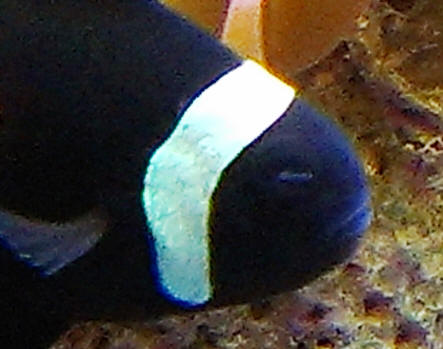 |
|
Black marks on clownfish in QT
1/25/14
Good afternoon!
<Jen>
After searching the internet for days and asking on forums with no
discernible answer, I decided it was time to ask the experts!
<Ok!>
My clownfish has been in a hospital tank, undergoing copper treatment
for white spot, for 3 weeks now. I originally had two in there but I
unfortunately lost the other smaller (male) black and white clown after
a few days in the HT. Mona, the larger of the two, is now cured of
Whitespot and doing well apart from these marks on her. She had a few
black marks that I assumed were caused by my Zoas when I first
transferred her. But these new marks look as if the original few spots
have dispersed and spread all over her.
<I see these/this>
After looking at pictures of clownfish changing colour as they mature,
I'm not convinced this is what's going on.... Those changes seem to be
from under the scales and look to be a more even spread of colour. This
looks more like the edges of her scaled are trimmed with black.
She is still eating well (tetra marine flakes twice a day, sometimes
three times. Once a day I add garlic Xtreme. I feed Mysis every couple
of days too). There's no ammonia in the HT, I do a 25% water change
every 4/5 days and have an ammonia badge in there too.
I've attached the best pics I could get with a rubbish camera and a fast
moving fish! The black shows up most between her middle and back white
line but is also on her fins.... Everywhere except her head!
Do you think I need to worry about her/do anything?
Thanks in advance for your help!
Jenny
<These markings look to be smudges; chromatophore, melanophore: color
cells on/in this fish... From? Copper exposure, gen. stress? I would NOT
treat for anything pathogenic here. Return this fish to optimized,
stable conditions and it should be fine. Bob Fenner>
|

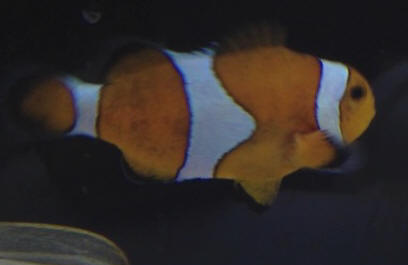 |
|
Re: Black marks on clownfish in QT
1/26/14
Bob, thanks so much for your response.
<Welcome Jen>
Yesterday was the last day of copper treatment at the recommended level
so I have now put carbon sponge and PolyFilter in the filter to remove
the copper, hopefully Mona will look less grubby soon! I was wondering
if lighting may also have had something to do with this and if I should
leave the tank light off for a few days? Do you think this may be a
factor?
<Not likely... the copper exposure by itself... most all. BobF>
Jen
|
|
|

